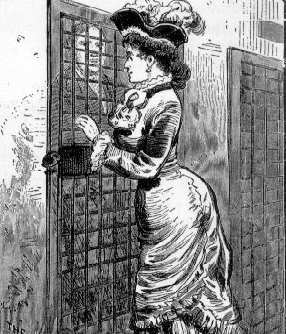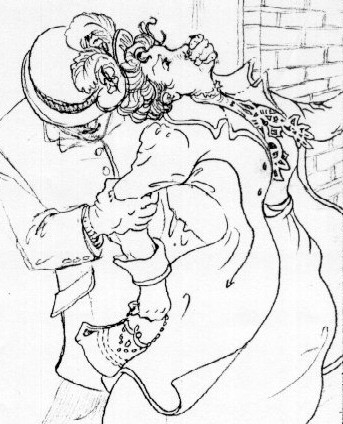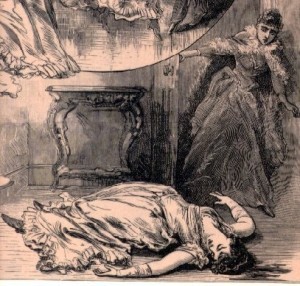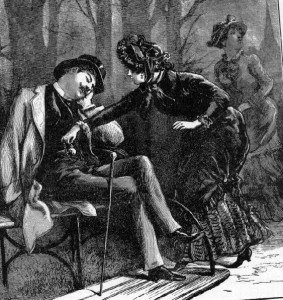You’d Think It Would Get Easier
Earlier this year I posted two blogs on the stages of writing a novel. “The Hardest Part” dealt with finding the right place to begin. “A Cure for the Middle-of-the-Book Blahs” was about some of the problems that crop up in mid-book. Now it’s time to talk about endings, or to be more exact, the last third or so of a work in progress.
 You’d think, having developed characters and written about them for fifty or sixty thousand words already, and having worked up a plot of some sort, that the push to the finish would be a piece of cake. By this point even pantsters like me have some idea where the story is going. While that’s true, there are also a lot of choices still to be made, plus a couple of pitfalls that aren’t always easy to avoid.
You’d think, having developed characters and written about them for fifty or sixty thousand words already, and having worked up a plot of some sort, that the push to the finish would be a piece of cake. By this point even pantsters like me have some idea where the story is going. While that’s true, there are also a lot of choices still to be made, plus a couple of pitfalls that aren’t always easy to avoid.
For one thing, there’s the exhaustion factor. I’ve been working on this mystery novel day after day, week after week for months. I really really want to get to the point where I can type “the end.” The scenes I’m writing right now are short on details and heavy on dialogue. They gallop along, hitting the plot points I need to include, and don’t have much depth to them, but at least I’m moving forward. This strong desire to finish will probably lead me to write a rushed climax and denouement that doesn’t do justice to what came before. I tend to be a bit too abrupt in wrapping things up, at least in my rough drafts. Fortunately, I’ll get a chance to improve those scenes when I revise, but that’s a topic for a blog of its own.
It would help if I had a clearer idea what will trigger the climactic scene. At least I’m in good company when I don’t yet know. As the now legendary story goes, until well into filming Star Wars, the script read only, “Darth Vader says something to make Luke mad.”
 Soon, I hope, I will figure out exactly what final clue will allow my detective to determine who dunnit. Confronting the villain may place her in mortal danger. I haven’t decided yet if that is what I want. If I do, will she rescue herself or will someone else have to step in to help her out of trouble? If the villain gets hold of the sleuth or some other important character, the stakes rise, suspense increases, and (in theory) it’s then an easy jump to the climax of the tale—a rescue or an escape; a fight; possibly a death. Ideally, readers end up eagerly turning pages to see what happens next. How to accomplish that in a way that is not a cliché is another tricky part of writing the end of the book.
Soon, I hope, I will figure out exactly what final clue will allow my detective to determine who dunnit. Confronting the villain may place her in mortal danger. I haven’t decided yet if that is what I want. If I do, will she rescue herself or will someone else have to step in to help her out of trouble? If the villain gets hold of the sleuth or some other important character, the stakes rise, suspense increases, and (in theory) it’s then an easy jump to the climax of the tale—a rescue or an escape; a fight; possibly a death. Ideally, readers end up eagerly turning pages to see what happens next. How to accomplish that in a way that is not a cliché is another tricky part of writing the end of the book.
In the best of all possible worlds, plot, subplots, and any loose ends are wrapped up in the last couple of pages and the reader finishes the novel feeling satisfied. Once everything is explained, it becomes apparent that the clues were there all along. The solution makes sense. The reader figured it out at about the same time the sleuth did or, failing that, will admit that the answers were only just out of reach. The author played fair. Providing such explanations, however, can become an end-of-the-book minefield for the writer.
 Many mysteries use a technique syndicated columnist Joel Achenbach called “the obligatory spilling of the beans,” a phrase he coined to mean the scene “where the villain explains his diabolical plot to rule the world, a moment of braggadocio that will lead to his downfall once the hero escapes.” This is the point at which the villain confesses to all his crimes and willingly answers any remaining questions, usually because he plans, immediately after confessing, to kill the sleuth. A last-minute escape or rescue prevents that outcome and the villain gets what’s coming to him (or her). Is the “spilling of the beans” overused? Yes and no. The same plot devices are used over and over again because they work, and because there just aren’t that many ways to bring a mystery novel to a satisfying conclusion. A variation of this is the gather-all-the-suspects-in-the-library ending, in which the sleuth, who may or may not know who dunnit, tricks the villain into confessing.
Many mysteries use a technique syndicated columnist Joel Achenbach called “the obligatory spilling of the beans,” a phrase he coined to mean the scene “where the villain explains his diabolical plot to rule the world, a moment of braggadocio that will lead to his downfall once the hero escapes.” This is the point at which the villain confesses to all his crimes and willingly answers any remaining questions, usually because he plans, immediately after confessing, to kill the sleuth. A last-minute escape or rescue prevents that outcome and the villain gets what’s coming to him (or her). Is the “spilling of the beans” overused? Yes and no. The same plot devices are used over and over again because they work, and because there just aren’t that many ways to bring a mystery novel to a satisfying conclusion. A variation of this is the gather-all-the-suspects-in-the-library ending, in which the sleuth, who may or may not know who dunnit, tricks the villain into confessing.
 An alternative to bean-spilling is to have the sleuth work out what must have happened and explain any elusive details to another character for the benefit of the reader. I always have a bit of a problem with this solution. It just doesn’t seem realistic that any one person could be brilliant enough to solve crime after crime with nary a misstep. I’d rather let my sleuth be misled, or even come up with a completely wrong explanation for the crime first, and then discover additional information that makes the pieces of the puzzle fall into place correctly.
An alternative to bean-spilling is to have the sleuth work out what must have happened and explain any elusive details to another character for the benefit of the reader. I always have a bit of a problem with this solution. It just doesn’t seem realistic that any one person could be brilliant enough to solve crime after crime with nary a misstep. I’d rather let my sleuth be misled, or even come up with a completely wrong explanation for the crime first, and then discover additional information that makes the pieces of the puzzle fall into place correctly.
As I go past the 60,000 word mark heading for 90,000 (on the historical mysteries) or pass 50,000, heading for 75,000 (for the Liss MacCrimmon novels), there are also other challenges to deal with. Holding information back from the reader is one of the hardest for me. Once I’ve worked out what really happened, my impulse is to share that information—or at least insert a big, honking clue. But if I do that too early, or even to hint too strongly at the villain’s identity, it will spoil the suspense.
Years ago, when I was writing Face Down Among the Winchester Geese, the third of the mysteries featuring Lady Appleton, my sixteenth-century gentlewoman, herbalist, and sleuth, she ended up identifying the killer some fifty pages before the end of the book, but she still had to figure out his motive. That quest led to a twist—the revelation of another person’s involvement in the murders. The clues were all there, but I held back this second person’s identity until the last possible moment. Will I try something like that again? I doubt it. It’s not easy to pull off successfully. On the other hand, variations are a possibility. My detective could have the right villain but the wrong motive, necessitating more sleuthing at greater risk. Or the villain might become desperate enough to do something totally unexpected. Twists and double twists at the end of a mystery novel? Great when they work but not easy to do well.
 I mentioned wrapping up subplots, but there are times when I feel a strong temptation not to do so. In a series, there are story arcs that carry over from book to book, usually having to do with the sleuth’s personal life. How much do I want to clear up and how much do I want to leave for the next installment? One thing I do know. I won’t commit the sin of leaving my readers in suspense about anything truly important. Fans were furious at having to wait an entire year to find out whether it was Joe or Ranger at Stephanie Plum’s door saying “Nice dress. Now take it off.” Not knowing if a beloved sidekick of the furry variety was alive or dead at the end of not one but two of Dana Stabenow’s mysteries upset many of her fans, including me. I will not do anything remotely similar to either of those things.
I mentioned wrapping up subplots, but there are times when I feel a strong temptation not to do so. In a series, there are story arcs that carry over from book to book, usually having to do with the sleuth’s personal life. How much do I want to clear up and how much do I want to leave for the next installment? One thing I do know. I won’t commit the sin of leaving my readers in suspense about anything truly important. Fans were furious at having to wait an entire year to find out whether it was Joe or Ranger at Stephanie Plum’s door saying “Nice dress. Now take it off.” Not knowing if a beloved sidekick of the furry variety was alive or dead at the end of not one but two of Dana Stabenow’s mysteries upset many of her fans, including me. I will not do anything remotely similar to either of those things.
The last third of the book is every bit as challenging to write as the first two thirds, especially the last two or three thousand words. When I finally type “the end” I plan to take a nice long break. Maybe work on an entirely different project for a month or two.
Then the revising starts.
Lea Wait's Blog
- Lea Wait's profile
- 509 followers



